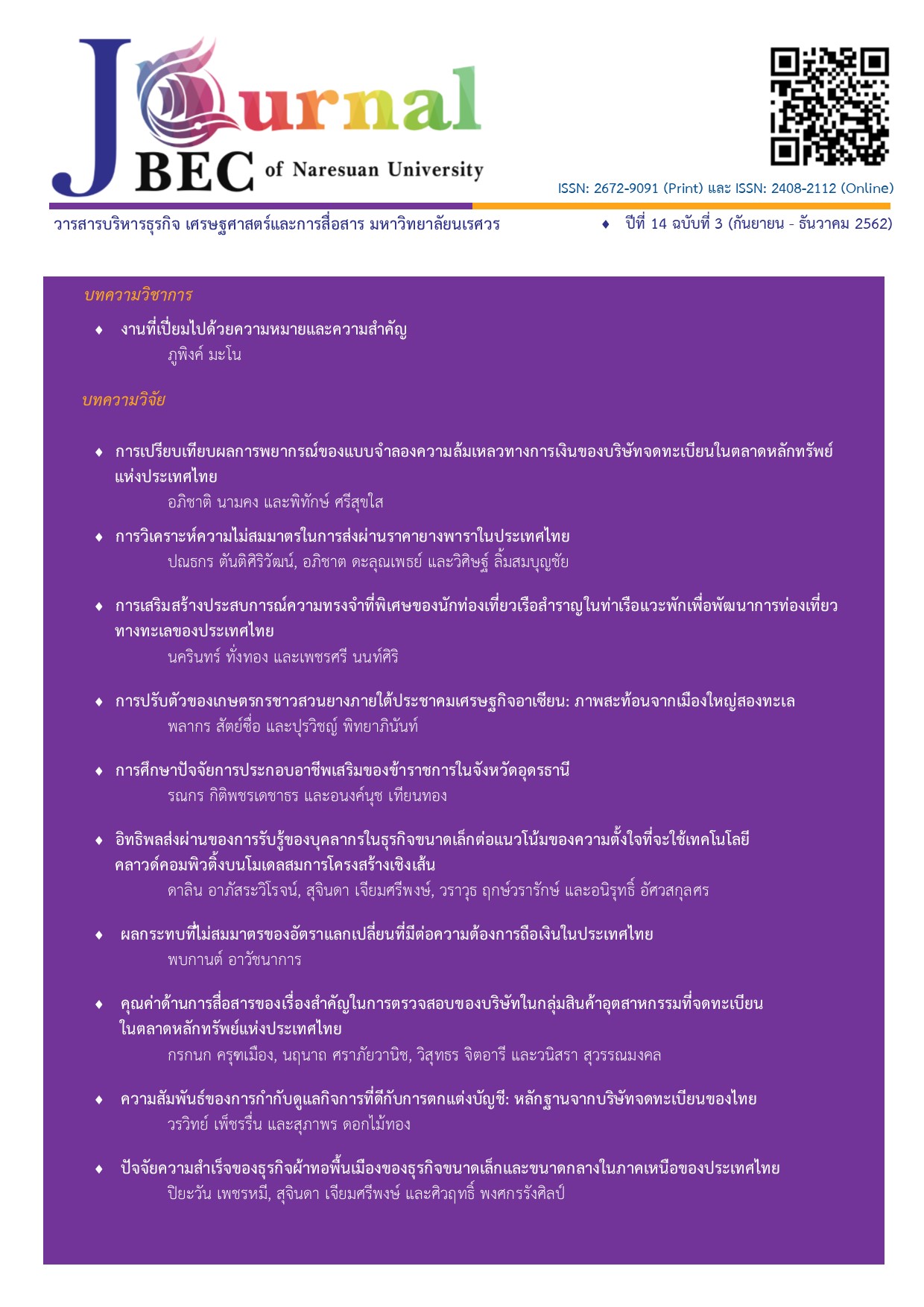ผลกระทบที่ไม่สมมาตรของอัตราแลกเปลี่ยนที่มีต่อความต้องการถือเงินในประเทศไทย
Main Article Content
บทคัดย่อ
บทคัดย่อ
งานศึกษาวิจัยนี้ ทำการศึกษาฟังก์ชันความต้องการถือเงินในประเทศไทยโดยใช้แบบจำลอง Autoregressive Distributed Lags (ARDL) and Non-Linear ARDL (NARDL) ในช่วงระหว่างปี พ.ศ. 2543 ไตรมาสที่ 2 ถึงปี พ.ศ. 2561 ไตรมาสที่ 2 ผลการศึกษาจากการประมาณค่าด้วยแบบจำลอง ARDL และ NARDL แสดงให้เห็นว่า ตัวแปรที่ใช้ในแบบจำลอง ได้แก่ ปริมาณความต้องการถือเงินที่แท้จริง อัตราแลกเปลี่ยนที่แท้จริง อัตราการเติบโตทางเศรษฐกิจ และอัตราดอกเบี้ยในตลาดการเงินของประเทศไทย มีความสัมพันธ์กันในระยะยาว ผลการศึกษาด้วยวิธี NARDL แสดงให้เห็นว่า อัตราแลกเปลี่ยนส่งผลกระทบในลักษณะที่ไม่สมมาตรต่อความต้องการถือเงินในประเทศไทย โดยผลการประมาณค่าแบบจำลองในระยะสั้น พบว่า การเปลี่ยนแปลงของ
อัตราแลกเปลี่ยนในทิศทางที่อ่อนค่าลง (POS) อัตราการเติบโตทางเศรษฐกิจและอัตราดอกเบี้ยของประเทศไทยส่งผลต่อความต้องการถือเงินอย่างมีนัยสำคัญทางสถิติ ขณะที่ในระยะยาว มีเพียงการเปลี่ยนแปลงอัตราแลกเปลี่ยนในทิศทางที่แข็งค่าขึ้น (NEG) และอัตราการเติบโตทางเศรษฐกิจที่ส่งผลต่อความต้องการถือเงิน
ในประเทศไทย นอกจากนี้ การประมาณค่าแบบจำลองด้วยวิธี NARDL มีความเหมาะสมในการประมาณแบบจำลองความต้องการถือเงินมากกว่าวิธี ARDL
คำสำคัญ: 1) ความต้องการถือเงิน 2) แบบจำลอง ARDL 3) แบบจำลอง NARDL 4) ประเทศไทย
Article Details
References
Alsamara, M. and Mrabet, Z. (2018). Asymmetric impacts of foreign exchange rate on the demand for money in Turkey: New evidence from nonlinear ARDL. International Economics and Economic Policy, 2018(1), 1-22.
Arwatchanakarn, P. (2018). Exchange rate policy, monetary policy and economic growth in Thailand: A macroeconomic study, 1950-2016. Doctoral dissertation, Ph.D., The University of Newcastle, Newcastle.
Bahmani-Oskooee, M. and Bahmani, S. (2015). Nonlinear ARDL approach and the demand for money in Iran. Economics Bulletin, 35(1), 381-391.
Hossain, A. A. and Arwatchanakarn, P. (2017). Does Money Have a Role in Monetary Policy for Price Stability under Inflation Targeting in Thailand?. Journal of Asian Economics, 53(December), 37-55.
Mahmood, H. and Alkhateeb, T. T. Y. (2018). Asymmetrical effects of real exchange rate on the money demand in Saudi Arabia: A non-linear ARDL approach. PLOS ONE, 13(11), 1-12.
Pesaran, M. H., Shin, Y. and Smith, R. J. (2001). Bounds testing approaches to the analysis of level relationships. Journal of Applied Econometrics, 16(3), 289-326.
Raksong, S. (2012). The money demand behavior under the inflation targeting framework in Thailand. Journal of the Academy of Business and Economics, 12(2), 54-65.
Shin, Y., Yu, B. and Greenwood-Nimmo, M. (2014). Modelling Asymmetric Cointegration and Dynamic Multipliers in a Nonlinear ARDL Framework. In R. C. Sickles and W. C. Horrace (Eds.), Festschrift in Honor of Peter Schmidt: Econometric Methods and Applications (pp. 281-314). New York: Springer New York.

